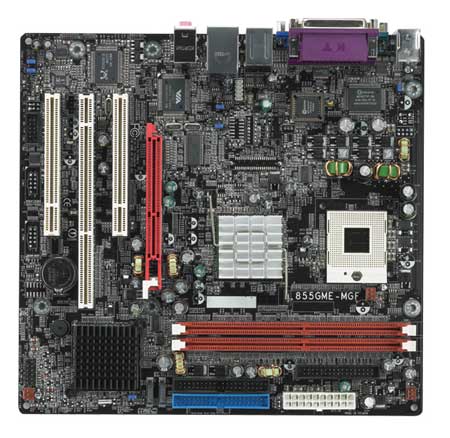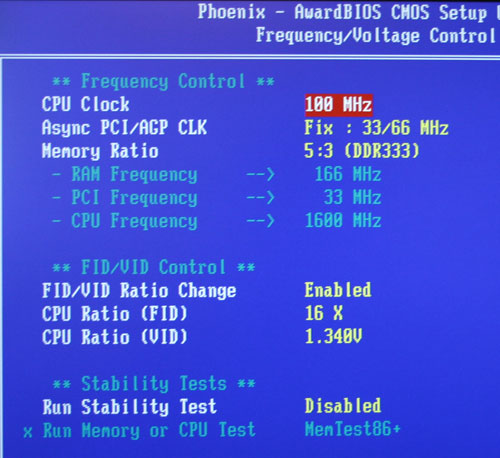Intel's Pentium M on the Desktop - A Viable Alternative?
by Anand Lal Shimpi on February 7, 2005 4:00 PM EST- Posted in
- CPUs
DFI 855GME-MGF
The DFI 855GME-MGF was originally designed for a customer who needed PCI-X support, so DFI used a server version of ICH5 that provided both PCI-X and SATA support (FWE6300ESB). The server ICH obviously contributes to the price of the board, but from what we've seen, the DFI board only commands a $10 price premium over the AOpen board.
Since it's based on the 855GME chipset, the board obviously features integrated video - but the performance is nothing to write home about. Unlike AOpen's board, there's only a single 10/100/1000 GigE port, but on the 855GME-MGF, you get a single FireWire 400 port on the I/O panel as well (instead of through a separate connector).
The 855GME-MGF only needs a 20-pin ATX power connector and no auxillary 4-pin +12V connector (unlike the AOpen board). The problem with DFI's layout, however, is the placement of a capacitor next to the 20-pin ATX power connector, which means that you can't use a 24-pin PSU with the board unless you have an adapter as the capacitor that won't let the additional 4 pins overhang.
The BIOS of the 855GME-MGF is very similar to the AOpen board in terms of options, but the actual layout for overclocking in the BIOS isn't as intuitive as it was on the AOpen board.

The stability of the DFI board was nothing to complain about, although it was far more sensitive to memory overclocking than the AOpen board was. When overclocked to the same levels that we were able to achieve on the AOpen board, the 855GME-MGF would randomly not POST between reboots. Usually a quick reboot would fix the problem, but it's still something that we'd rather not deal with. While we could easily hit 2.4GHz on the AOpen board, we found that 2.26GHz was the only stable overclock that we could achieve on the DFI motherboard (with all other variables, such as memory speed, the same).
The voltage adjustments are equally as disappointing on the 855GME-MGF. You can only adjust Vcore up to a maximum of 1.340V. And just like the AOpen board, although the 855GME-MGF only officially supports the 400MHz FSB, reaching 533MHz isn't a problem at all.
DFI's cooling solution is a little different from AOpen's, as they include a smaller but taller heatsink that screws on to a backplate. Both DFI and AOpen's fans were similarly quiet. AOpen's heatsink relied on thermal grease to improve heat transfer, while DFI's solution has a layer of thermal conductive material already on the base of the heatsink. The advantage to AOpen's method of just supplying thermal grease is that it's easier to reapply if you switch CPUs often, rather than the material that's present on the DFI heatsink.
Overall, the DFI is just as capable of a board as AOpen's solution, and is the only solution that offers a PCI-X slot if that matters to you. However, the BIOS layout, reduced stability when overclocking, and a slightly higher price point give the nod to AOpen for our overall recommendation.
The DFI 855GME-MGF currently sells for $239.










77 Comments
View All Comments
bobsmith1492 - Monday, February 7, 2005 - link
Granted the T8000 here is an Intel fanboy, but please notice Anand was comparing clock-for-clock.T8000 - Monday, February 7, 2005 - link
There is one big difference between this review and the reviews where the Pentium M did very well: CLOCKSPEED!While others where able to get over 2.8 Ghz with aircooling, Anand got just 2.4 Ghz. This may be a coincidence, but it is the difference between surprisingly good performance and a few % below others.
As most of the benchmarks where based on the stock 2 Ghz, the difference became even greater.
So this review just shows that the stock speed Pentium M performs about 30% less with about 30% less clockspeed than overclocked versions.
A slightly redesigned version with higher voltages is not extremely unlikely to hit at least 3 Ghz. Combining that with a desktop chipset will result in stellar performance, as the benchmark scores in this review (x1.5) indicate.
But since there is no slightly redesigned version and Intel has no good reason to make one, the current Pentium M desktops will only appeal to overclockers and silent computing people.
Also, for some reason, Anand found the 90W TDP of the 2.4 Ghz A64 closer to the 20W of the P-M than to the 110W of the 3.8 Ghz P4.
CSMR - Monday, February 7, 2005 - link
That's a very good option Zebo, thanks for posting it.teutonicknight - Monday, February 7, 2005 - link
One suggestion: Why don't you start using a newer version of Premiere for testing? I personally don't use it, but every that I know who does says before Premiere Pro, the program sucked. I'm sure the render results would be much more realistic and accurate if you used a more up to date version of the programRegs - Monday, February 7, 2005 - link
I was wondering the same thing too Jeff. If you feed it more bandwidth, it would eliminate the pipeline stalls and maybe give it a chance to reach higher clock speeds. Right? Or is it still prohibited by the shorter pipeline to reach higher clock speeds?Longer pipeline = wasted clock cycles. But to me that sounds like the PM should actually scale a lot better with a speed boost. Why exactly does it scale badly compared to a P4? Could it be remedied in anyway with a dual channel memory bus?
ozzimark - Monday, February 7, 2005 - link
there's something wrong with the 3400+ in the spec tests. why is the 3000+ beating it consitantly?Warder45 - Monday, February 7, 2005 - link
Maybe I missed something but I don't see the reason for all the negitivity in the final words. The 2.4Ghz P-M was very close to the A64 2.4Ghz in many of the tests, 3D rendering seemed to slow it down but that looked like it. With better boards and memory the P-M might best the A64 in a clock for clock match up.I do agree the prices are way too high. I think Intel really needs to wake up and smell what they have cooking here. With more support and more aggressive priceing they could easily have a winner in the HTPC and SFF markets.
plewis00 - Monday, February 7, 2005 - link
Surely when someone builds a mainboard with the Sonoma (i915) platform using PCI-E and DDR2-533 then it will change. And I wouldn't have thought that's that far off assuming they don't charge rip-off prices for the technology. It would also be perfect for Shuttle systems where the emphasis is on quietness and coolness rather than so much on performance.Zebo - Monday, February 7, 2005 - link
CSMRSo's this one very soon..
http://www.xtremesystems.org/forums/showthread.php...
...more than excellent performance wise if Dothan is excellent...power differential hopefully for AMD will be nominal.
Sokaku - Monday, February 7, 2005 - link
While it is true that the A64 has way more bandwidth, I doubt that is the reason why it crushed the P-M in the Professional Applications. I think the real cause is to be found in the P-M's abillity to do FP divisions. The P-III had a pipelined FP unit, however div operations were extremly expensive. My guess would be that Intel haven't thrown much effort into improving on this.